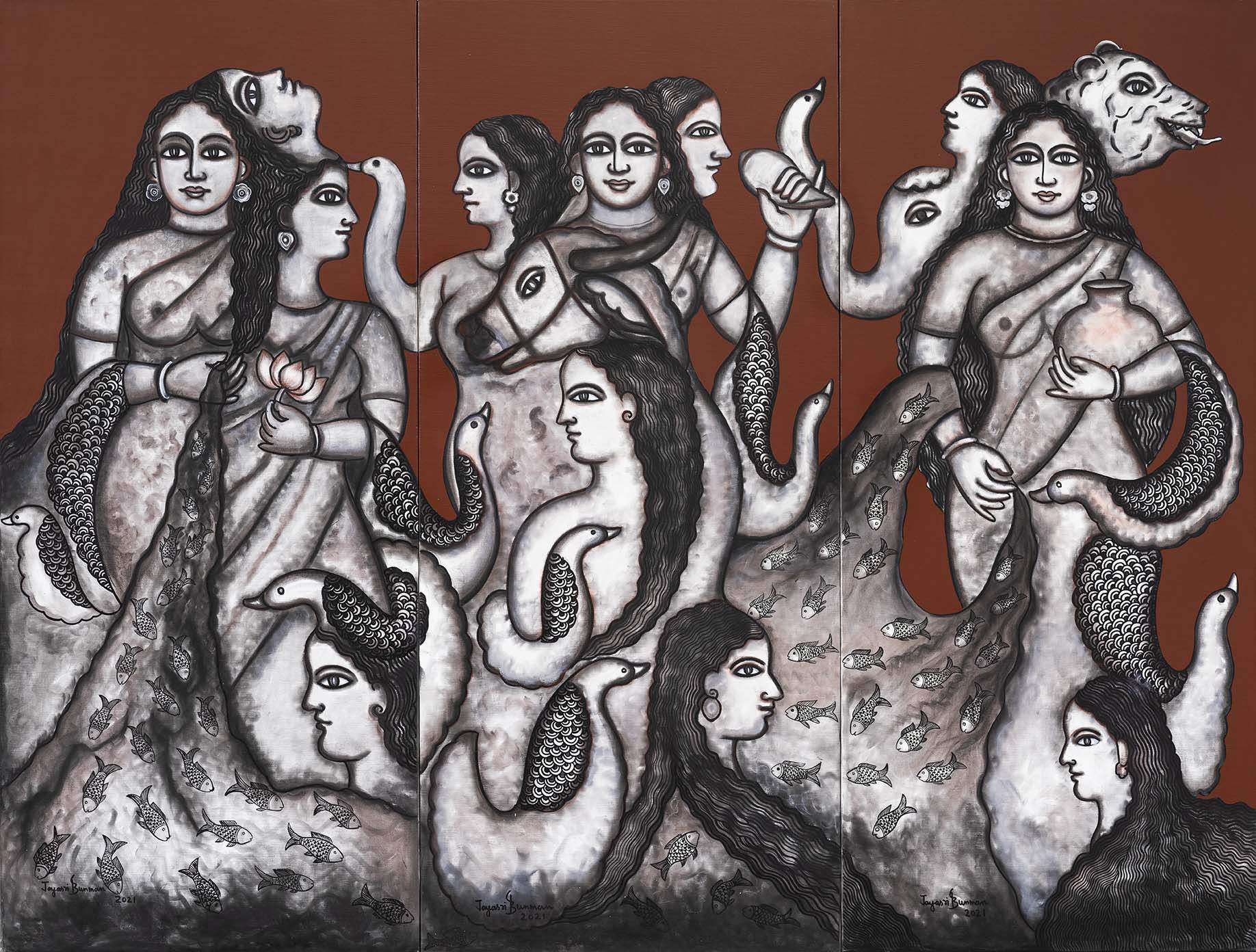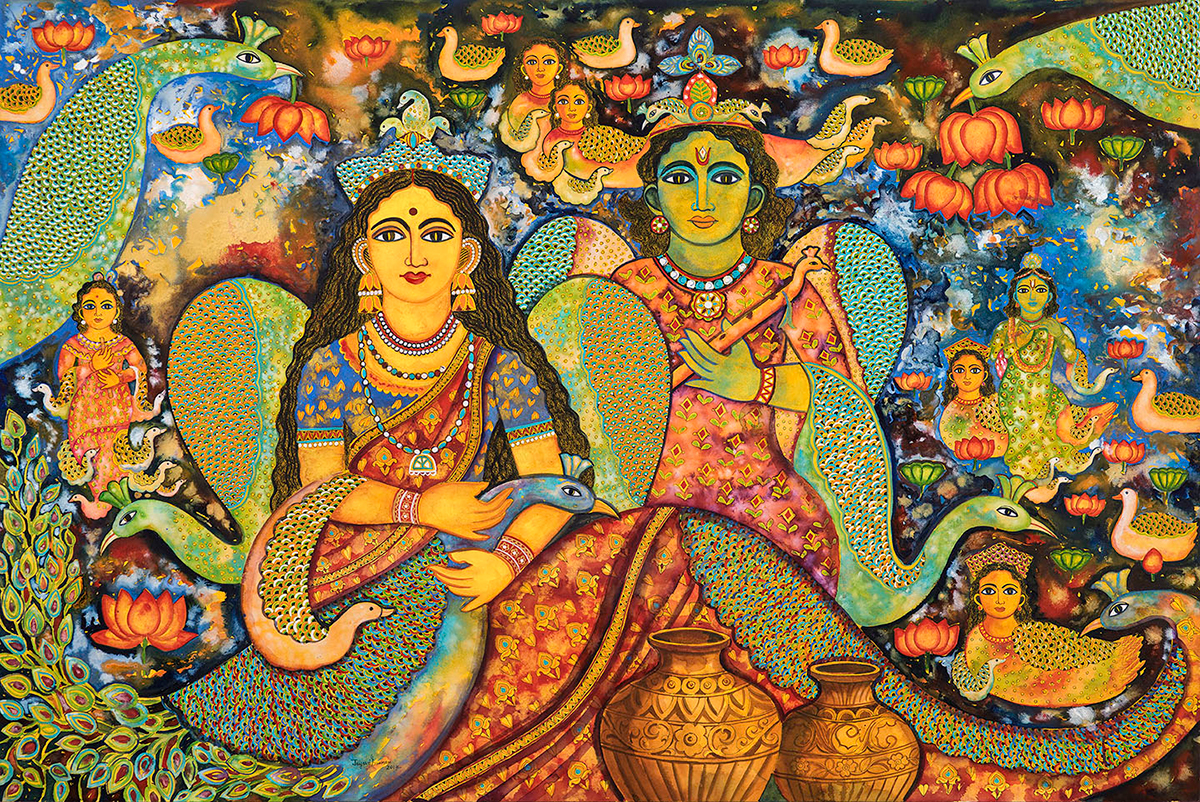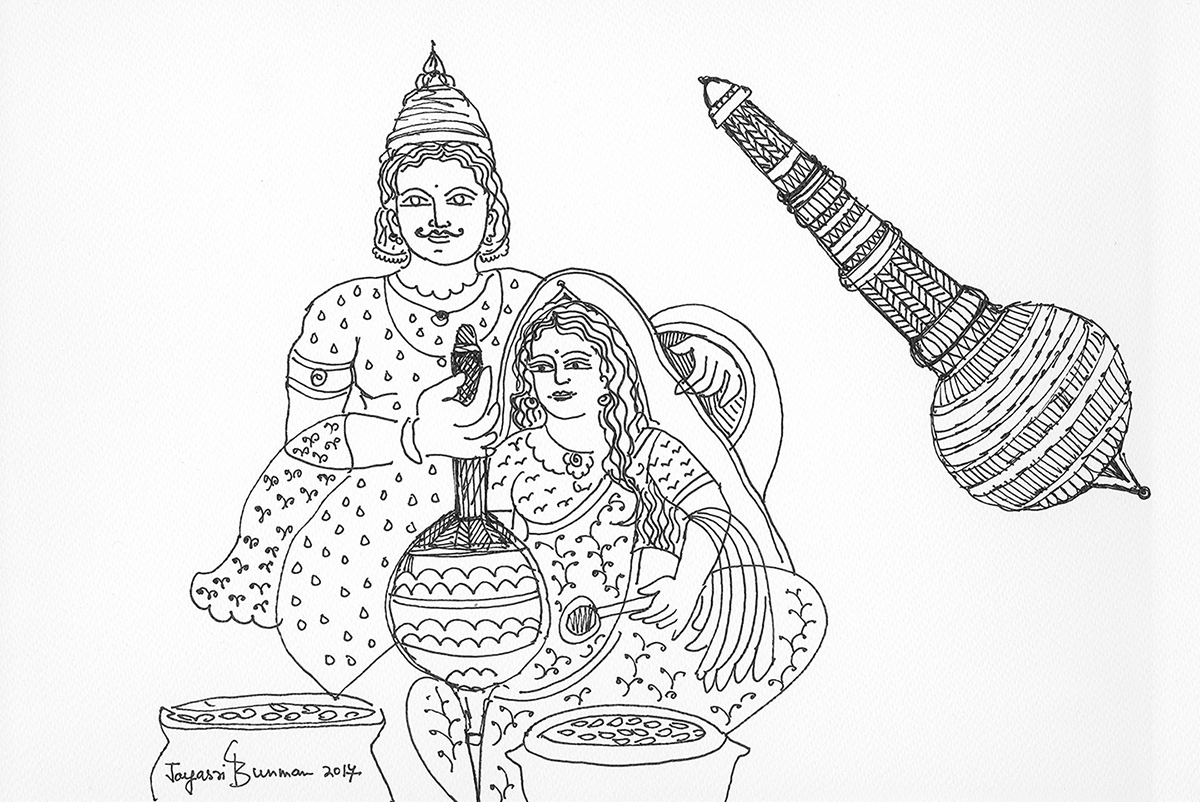River of Faith
The world has seen much strife and struggles in the past two years with the arrival of the pandemic. Nature and humanity have faced unprecedented setbacks. Deeply sensitive and a seeker of beauty and truth as ingrained in her through her early intimacy with scriptures, Jayasri has created through the contrasting medium of paintings and sculptures her poetic offering honoring the mighty Ganges which seem to be a universal thread binding humanity.
As an artist and humanist moved by the extreme desecration and pollution of the sacred waters of Ganges, she has presented a vibrant ensemble of creations in her show, “River of Faith” that questions, arouses, sensitizes and soothes, calling the audience attention to the river as a life force that instills strength, hope and spirit of preservation albeit the upheavals that frequent it.
Her works take us to the history and evolution of how the river came into being. Viewers are invited to travel through the different forms and names assumed by the river Ganges depicted through beautiful goddesses and female nymph-like forms. Through the exquisite detailing, some colorful, some in black and white the artist seems to focus on forces and frailties of human existence with the cosmic cycle of birth and rebirth as our traditions make us brush with the river - in life, celebrations and on our final journey.
As the world awaits to rediscover normalcy and happiness leaving behind the shadows and sorrows of the pandemic, the River of Faith is a beautiful tribute to the river and serves to gently remind us about restoring balance and tranquility in our lives, and repose our faith in nature and its powers.
Born of Fire
From my reading of the epic, the character of Draupadi always stood out as a woman of substance who was not afraid to speak her mind. The unusual circumstances of her appearance heralded the life Draupadi would lead as a rebellious princess, a constant seeker of justice. Her unexpected manifestation from the sacred flames may have left her father, King Dhrupad, momentarily astonished, but Draupadi herself emerged unscathed from the flames, a beautiful woman whose complexion was as radiant as the flames that surrounded her.
From her birth, Draupadi’s entire being was fiery and resolute, it was as if she came to the world with a mission. In the epic there are other characters too who remain etched in our memories but somehow, ever since I first read Mahabharata, it was Draupadi’s character that always stood out. How can one forget that time and again she willingly sacrificed her own passions, desires and maternal love, all for the sake of justice.
Her beauty, as described in the epic was that of an unconventional woman who defied the prevalent norms of the royal court. She was her own person, one who did not care about race, caste and colour. When Arjun won her hand in the Swayamvara, she had to accept five husbands because she knew that was what her destiny had in store. She fulfilled her wifely duties to the Pancha Pandavas with grace and devotion, treating each husband with love and affection even though in her heart of hearts, she secretly loved Arjun more than the others. However, her sacrifices yielded little in return. Like Nature endures hardships of tempests, storms, the rage of seas and violent explosions of the volcanoes, so too Draupadi accepted her fate with all its vicissitudes, uncomplainingly. To me, Draupadi is the truest champion of justice and fair play, she stands for women rights and humanity.
At the end of their earthly lives when they were on their way to heaven, Draupadi falls to her mortal death but the Pandavas do not spare her a glance and carry on. In my eyes, it is significant that Draupadi is sent back to the earth. Draupadi is our symbol of hope and fortitude and (I believe) she must remain in the midst of our lives as an iconic woman we can all draw inspiration from. She belongs to us!
Born of Fire - Sketches
From my reading of the epic, the character of Draupadi always stood out as a woman of substance who was not afraid to speak her mind. The unusual circumstances of her appearance heralded the life Draupadi would lead as a rebellious princess, a constant seeker of justice. Her unexpected manifestation from the sacred flames may have left her father, King Dhrupad, momentarily astonished, but Draupadi herself emerged unscathed from the flames, a beautiful woman whose complexion was as radiant as the flames that surrounded her.
From her birth, Draupadi’s entire being was fiery and resolute, it was as if she came to the world with a mission. In the epic there are other characters too who remain etched in our memories but somehow, ever since I first read Mahabharata, it was Draupadi’s character that always stood out. How can one forget that time and again she willingly sacrificed her own passions, desires and maternal love, all for the sake of justice.
Her beauty, as described in the epic was that of an unconventional woman who defied the prevalent norms of the royal court. She was her own person, one who did not care about race, caste and colour. When Arjun won her hand in the Swayamvara, she had to accept five husbands because she knew that was what her destiny had in store. She fulfilled her wifely duties to the Pancha Pandavas with grace and devotion, treating each husband with love and affection even though in her heart of hearts, she secretly loved Arjun more than the others. However, her sacrifices yielded little in return. Like Nature endures hardships of tempests, storms, the rage of seas and violent explosions of the volcanoes, so too Draupadi accepted her fate with all its vicissitudes, uncomplainingly. To me, Draupadi is the truest champion of justice and fair play, she stands for women rights and humanity.
At the end of their earthly lives when they were on their way to heaven, Draupadi falls to her mortal death but the Pandavas do not spare her a glance and carry on. In my eyes, it is significant that Draupadi is sent back to the earth. Draupadi is our symbol of hope and fortitude and (I believe) she must remain in the midst of our lives as an iconic woman we can all draw inspiration from. She belongs to us!
Primordial Power
Thousands of devotees wholeheartedly dedicate colourful votive churnis on their gods and goddesses, committed to a deep faith, unrestrained, unquestioningly. From here springs a strange and wonderful belief to battle every unforeseen hurdle. Every nook and corner in India, every lane and by laneis garlanded with votives of faith on trees and stones, temples and mosques, weaving the tale of their hopes. In my installation, I have used it to exemplify the reflection of that innate belief. I have also used the tiger’s face extravagantly, as we know it as one of the divine vehicles. The regal look of a tigerexudes a power; the abstract notion of an intangible force that destroys evil and builds strength of hope. The tiger finds its roots in my birthplace, Bengal, which prides in harbouring the Royal Bengal Tiger. It will also not be wrong to mention that they are reminiscent off the panel where they are "prancing, proud and unafraid" in Adrienne Rich’s ‘Aunt Jennifer’s Tigers’, basking in their feminine fires.




